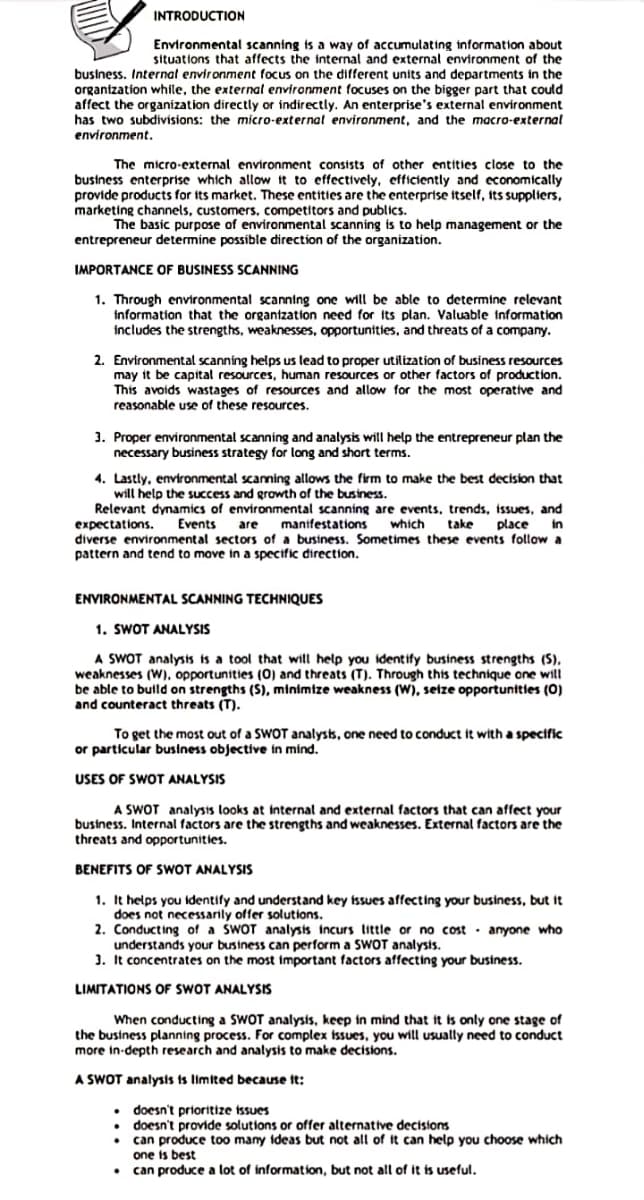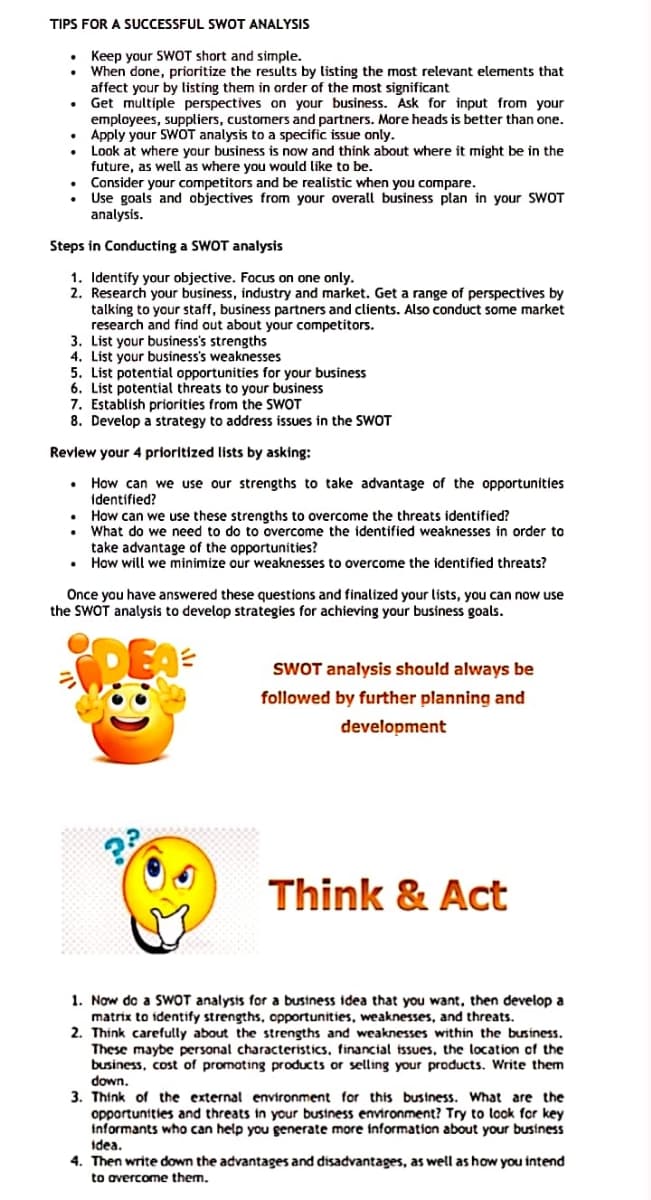This is not a WRITING ASSIGNMENT • Generate a UNIQUE BUSINESS IDEA using one of the methods/ tools in business idea generation discussed in the given image. After coming up with a final business idea, conduct an ENVIRONMENTAL SCANNING using the following techniques: 1.SWOT Analysis 2.PESTLE Analysis
This is not a WRITING ASSIGNMENT • Generate a UNIQUE BUSINESS IDEA using one of the methods/ tools in business idea generation discussed in the given image. After coming up with a final business idea, conduct an ENVIRONMENTAL SCANNING using the following techniques: 1.SWOT Analysis 2.PESTLE Analysis
Principles Of Marketing
17th Edition
ISBN:9780134492513
Author:Kotler, Philip, Armstrong, Gary (gary M.)
Publisher:Kotler, Philip, Armstrong, Gary (gary M.)
Chapter1: Marketing: Creating Customer Value And Engagement
Section: Chapter Questions
Problem 1.1DQ
Related questions
Question
This is not a WRITING ASSIGNMENT
• Generate a UNIQUE BUSINESS IDEA using one of the methods/ tools in business idea generation discussed in the given image. After coming up with a final business idea, conduct an ENVIRONMENTAL SCANNING using the following techniques:
1.SWOT Analysis
2.PESTLE Analysis

Transcribed Image Text:INTRODUCTION
Environmental scanning is a way of accumulating information about
situations that affects the internal and external environment of the
business. Internal environment focus on the different units and departments in the
organization while, the external environment focuses on the bigger part that could
affect the organization directly or indirectly. An enterprise's external environment
has two subdivisions: the micro-external environment, and the macro-external
environment.
The micro-external environment consists of other entities close to the
bustness enterprise which allow it to effectively, efficiently and economically
provide products for ts market. These entities are the enterprise itself, its suppliers,
marketing channels, customers, competitors and publics.
The basic purpose of environmental scanning is to help management or the
entrepreneur determine possible direction of the organization.
IMPORTANCE OF BUSINESS SCANNING
1. Through environmental scanning one will be able to determine relevant
information that the organtzation need for its plan. Valuable information
includes the strengths, weaknesses, opportunities, and threats of a company.
2. Environmental scanning helps us lead to proper utilization of business resources
may it be capital resources, human resources or other factors of production.
This avoids wastages of resources and allow for the most operative and
reasonable use of these resources.
1. Proper environmental scanning and analysis will help the entrepreneur plan the
necessary business strategy for long and short terms.
4. Lastly, environmental scanning allows the firm to make the best decision that
will help the success and growth of the business.
Relevant dynamics of environmental scanning are events, trends, issues, and
Events are manifestations
which take
place
in
expectations.
diverse environmental sectors of a business. Sometimes these events follow a
pattern and tend to move in a specific direction.
ENVIRONMENTAL SCANNING TECHNIQUES
1. SWOT ANALYSIS
A SWOT analysis is a tool that will help you identify business strengths (S),
weaknesses (W), opportunities (0) and threats (T). Through this technique one will
be able to bulld on strengths (S), minimize weakness (W), seize opportunities (0)
and counteract threats (T).
To get the most out of a SWOT analysts, one need to conduct it with a specific
or particular business objective in mind.
USES OF SWOT ANALYSIS
A SWOT analysis looks at internal and external factors that can affect your
business. Internal factors are the strengths and weaknesses. External factors are the
threats and opportunities.
BENEFITS OF SWOT ANALYSIS
1. It helps you identify and understand key issues affecting your business, but it
does not necessarily offer solutions.
2. Conducting of a SWOT analysis incurs little or no cost · anyone who
understands your business can perform a SWOT analysis.
1. It concentrates on the most important factors affecting your business.
LIMITATIONS OF SWOT ANALYSIS
When conducting a SWOT analysis, keep in mind that it is only one stage of
the business planning process. For complex issues, you will usually need to conduct
more in-depth research and analysis to make decisions.
A SWOT analysis is limited because it:
doesn't prioritize issues
doesn't provide solutions or offer alternative decistons
can produce too many ideas but not all of it can help you choose which
one is best
can produce a lot of information, but not all of it is useful.

Transcribed Image Text:TIPS FOR A SUCCESSFUL SWOT ANALYSIS
S
• Keep your SWOT short and simple.
When done, prioritize the results by listing the most relevant elements that
affect your by listing them in order of the most significant
Get multiple perspectives on your business. Ask for input from your
employees, suppliers, customers and partners. More heads is better than one.
• Apply your SWOT analysis to a specific issue only.
Look at where your business is now and think about where it might be in the
future, as well as where you would like to be.
Consider your competitors and be realistic when you compare.
Use goals and objectives from your overall business plan in your SWOT
analysis.
Steps in Conducting a SWOT analysis
1. Identify your objective. Focus on one only.
2. Research your business, industry and market. Get a range of perspectives by
talking to your staff, business partners and clients. Also conduct some market
research and find out about your competitors.
3. List your business's strengths
4. List your business's weaknesses
5. List potential opportunities for your business
6. List potential threats to your business
7. Establish priorities from the SWOT
8. Develop a strategy to address issues in the SWOT
Review your 4 prioritized lists by asking:
How can we use our strengths to take advantage of the opportunities
identified?
• How can we use these strengths to overcome the threats identified?
What do we need to do to overcome the identified weaknesses in order to
take advantage of the opportunities?
• How will we minimize our weaknesses to overcome the identified threats?
Once you have answered these questions and finalized your lists, you can now use
the SWOT analysis to develop strategies for achieving your business goals.
SWOT analysis should always be
followed by further planning and
development
Think & Act
1. Now do a SWOT analysis for a bustness idea that you want, then develop a
matrix to identify strengths, opportunities, weaknesses, and threats.
2. Think carefully about the strengths and weaknesses within the business.
These maybe personal characteristics, financial tssues, the location of the
business, cost of promoting products or selling your products. Write them
down.
3. Thínk of the external environment for this business. What are the
opportunities and threats in your business environment? Try to look for key
informants who can help you generate more information about your business
idea.
4. Then write down the advantages and disadvantages, as well as how you intend
to avercome them.
Expert Solution
This question has been solved!
Explore an expertly crafted, step-by-step solution for a thorough understanding of key concepts.
Step by step
Solved in 3 steps

Recommended textbooks for you

Principles Of Marketing
Marketing
ISBN:
9780134492513
Author:
Kotler, Philip, Armstrong, Gary (gary M.)
Publisher:
Pearson Higher Education,

Marketing
Marketing
ISBN:
9781259924040
Author:
Roger A. Kerin, Steven W. Hartley
Publisher:
McGraw-Hill Education

Foundations of Business (MindTap Course List)
Marketing
ISBN:
9781337386920
Author:
William M. Pride, Robert J. Hughes, Jack R. Kapoor
Publisher:
Cengage Learning

Principles Of Marketing
Marketing
ISBN:
9780134492513
Author:
Kotler, Philip, Armstrong, Gary (gary M.)
Publisher:
Pearson Higher Education,

Marketing
Marketing
ISBN:
9781259924040
Author:
Roger A. Kerin, Steven W. Hartley
Publisher:
McGraw-Hill Education

Foundations of Business (MindTap Course List)
Marketing
ISBN:
9781337386920
Author:
William M. Pride, Robert J. Hughes, Jack R. Kapoor
Publisher:
Cengage Learning

Marketing: An Introduction (13th Edition)
Marketing
ISBN:
9780134149530
Author:
Gary Armstrong, Philip Kotler
Publisher:
PEARSON


Contemporary Marketing
Marketing
ISBN:
9780357033777
Author:
Louis E. Boone, David L. Kurtz
Publisher:
Cengage Learning